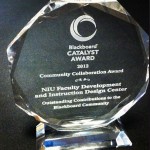One of the many highlights for me from BbWorld 2012 was to accept on behalf of all the colleagues I work with at NIU, the 2012 Blackboard Catalyst Award for Community Collaboration. This award recognizes leaders within the Blackboard user community who encourage collaboration, and share advice, insight, content, and effective practices with fellow educators outside their own institutions.

Accepting the 2012 Blackboard Catalyst Award from Ray Henderson, President and Chief Technology Office, Blackboard
Our center was recognized for its long history of collaborating with others in the support of teaching with technology, sharing advice, insight, and best practices. This was the second year in a row our Center was recognized with a Blackboard Catalyst Award, with last year’s award being for excellence in professional development.
I am indeed blessed to work with an amazing team of colleagues at NIU and look forward to the future as we together we continue to make every effort at being “catalysts” in support of the the teaching mission of NIU.









